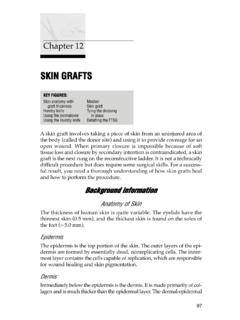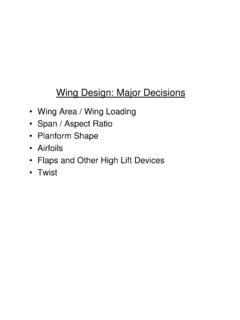Transcription of LOCAL FLAPS - Practical Plastic Surgery
1 LLOOCCAALL FFLLAAPPSSDD eeffiinniittiioonnssAflapis a piece of tissue with a blood supply that can be used to coveran open wound. A flap can be created from skin with its underlyingsubcutaneous tissue, fascia, or muscle, either individually or in somecombination. Depending on the reconstructive requirements, evenbone can be included in a flapimplies that the tissue is adjacent to the open wound inneed of coverage, whereas in a distant flap , the tissue is brought froman area away from the open wound. LOCAL flap coverageof a wound is the next higher rung up the recon-structive ladder after a skin graft. Examples of wounds that require flapcoverage include wounds with exposed bone, tendon, or other vitalstructure and large wounds over a flexion crease, for which a split-thickness skin graft or secondary closure would result in tight site:where the flap site:the open wound/soft tissue defect in need of :the blood supply of the flap ( , its arterial inflow andvenous outflow).
2 The pedicle varies from a wide bridge of tissue (skin,subcutaneous tissue, muscle, or some combination) to an isolatedartery and vein. Most LOCAL FLAPS can be classified as either (1) skin FLAPS , which are skinand subcutaneous tissue with or without the underlying fascia, or (2)muscle FLAPS , which are created from a muscle with or without the at-tached overlying 13 KKEEYY FFIIGGUURREESS::Axial flap noting pedicleRhomboid flapRandom flap notingRotation flappedicle and 3:1 ratioV-Y advancement flap112 Practical Plastic Surgery for NonsurgeonsSSkkiinn FFllaappssA portion of skin and subcutaneous tissue and, when possible, the under-lying fascia (the thin layer of connective tissue overlying muscle that hasan excellent vascular supply) is moved to fill the defect. This movement oftissue results in a new defect at the donor site. Often the donor site can beclosed primarily, but sometimes a skin graft is FLAPS are classified as either axialor random. The classification isbased on the blood FlapsThe circulation of an axial flap is supplied by specific, identifiableblood vessels.
3 Careful anatomic study has identified several donorsites with a single artery and vein responsible for circulation to a par-ticular area of skin. Examples include the volar forearm skin suppliedby the radial artery and skin on the back supplied by the circumflexscapular artery (a branch of the thoracodorsal artery).Circulation based on specific vessels results in a highly reliable bloodsupply and a reliable flap . You can be confident that unless there is aninjury to the vessels, the majority of the flap tissue should survive in itsnew position. Axial flap . Note that the blood supply comes from an identifiable vessel. As aresult, the pedicle can be quite thin, which makes transferring the flap to itsnew site an easier FLAPS 113An axial flap can be completely detached from all surrounding tissue aslong as it remains connected to its supplying blood vessels. These ves-sels serve as the pedicle. The thin pedicle allows axial FLAPS to be easilypositioned to fill the wound defect (unlike the random flap [see below]).
4 The difficulty with an axial flap is locating the blood vessels. You mustbe very careful not to injure the vessels when creating the flap . The nec-essary technical expertise is beyond the realm of most providers with-out reconstructive surgical training. Thus, no specific axial skin flapsare discussed in this FlapsCirculation to a random flap is provided in a diffuse fashion throughtiny vascular connections from the pedicle into the flap . The pediclemust be bulky to increase the number of vascular connections. Themore vascular connections, the better the circulation to the flap . Thebetter the circulation to the flap , the better its general, a random flap does not have as reliable a blood supply asan axial flap . Nonetheless, the relative ease of creating random flapsmakes them useful almost anywhere on the body. The circulation andthus the reliability of the flap can be increased by delaying the flapbefore final transfer. Delay ProcedureBefore the flap is created, the tissue gets its blood supply via all of thesurrounding skin and underlying tissue attachments.
5 When the flap iscreated, the circulation to the flap comes only from the skin flap . The blood supply comes diffusely from the remaining skinattachment, which serves as the pedicle. For optimal circulation and flap sur-vival, the flap should be designed so that the length is no more than three timesthe Practical Plastic Surgery for NonsurgeonsThe purpose of the delay procedure is to enable the pedicle to assumeits role as the main source of circulation before the flap is moved to itsnew position. This goal is obtained by making some of the incisionsneeded to create the flap but not separating the flap from the underly-ing tissues. The flap is not moved to its new position; instead, the skinedges are sutured together total blood supplied to the flap initially decreases when the inci-sions are made. This decrease promotes opening of new vascular chan-nels between the pedicle and flap . Thus, more blood will flow into theflap through the pedicle than if the delay procedure had not been the flap before final transfer allows more confidence in theviability of the flap .
6 Wait about 7 10 days after the delay procedurebefore moving the flap to the recipient ffoorr CCrreeaattiinngg RRaannddoomm LLooccaall FFllaappssWhen creating a random LOCAL skin flap , you take advantage of the rel-atively loose, excess skin in the vicinity of the skin defect. Randomflaps require less technical expertise than axial FLAPS . Because they canbe quite useful for covering an open wound, several types of randomflaps are discussed in detail InformationRandom flap procedures often can be done under LOCAL anesthesia ifthe area ( flap plus defect) is not too large (< 8 10 cm). For larger areas,general anesthesia probably will be sure to clean the wound thoroughly before creating and placing the a scrub brush or the flat part of a scalpel to scrape away the top layerof granulation tissue from the wound. Then wash with saline. The woundprobably will bleed, but gentle pressure should control the :Outline the flap before making any incisions. A water-based magicmarker allows you to make corrections to your design before making anyincisions.
7 Incorrect marks can be removed by wiping with part of the flap at highest risk for poor circulation is the tip of theflap (the tissue farthest from the pedicle). Unfortunately, the tip of theflap is usually the most important part of the flap because it is the partthat provides coverage for the open optimize circulation and reliability of a random flap , Plastic surgeonsheed the 3:1 rule. The flap should not be longer than 3 times its the flap is also FLAPS 115 Unfortunately, the thickness of the pedicle can make it difficult tomove the flap to its new position. Minimal tension should be applied to theflap when it is sutured into on the flap decreases circulationand can lead to tissue necrosis (death). You can tell that too much ten-sion has been applied if portions of the flap look pale once it is in itsnew the donor site cannot be closed primarily without placing tension onthe flap , avoid primary closure. A skin graft can be used to cover thedonor site defect or, if the defect is just a few cm, it can be allowed toheal secondarily.
8 For coverage of a wound > 7 8 cm, it is useful to place a drain underthe flap to prevent collection of fluid, which will interfere with drain can be a suction drain, if available, or a passive drain ( ,Penrose drain). A piece of sterile glove can substitute for a Penrosedrain. The drain usually can be removed after 48 hours. Rhomboid FlapsIndicationsRhomboid FLAPS are useful for wounds up to 4 or 5 cm in diameter onthe face, trunk, or extremity. They are especially useful when there isnot enough laxity in the surrounding tissues to create one of the otherflaps discussed Measure the diameter of the Determine the site of greatest surrounding skin laxity (pinch the tis-sues to see where it is easiest to pull up on the skin). Draw a linefrom the wound edge into this tissue. This line, which represents thefirst incision, should be approximately 75% of the wound diameter. 3. Draw another line at a 60 angle to this extension, parallel to theedge of the defect. This line should be the same length as the line instep 2.
9 These lines outline your Be careful not to make the pedicle of the flap too narrow. 5. Make the incisions along the lines placed in steps 2 and 3. Incise theskin and subcutaneous tissue of the flap down to, but not including,the underlying Use a knife to lift the flap off the underlying muscle, trying to keepthe fascia attached to the flap to enhance circulation. You shouldalso separate the pedicle and some of the tissues around the wound116 Practical Plastic Surgery for Nonsurgeonsdefect from the underlying muscle. This technique is called undermin-ing. Undermining allows more mobility in the flap and surroundingtissues, which in turn facilitates wound and donor site The flap now should be ready to be moved into the wound, and thedonor site should be closed Loosely suture the flap in place, taking care to avoid tension on thepedicle. Place a few dermal sutures, and then do an interrupted skinclosure. Be sure that the skin closure is not tight. It is better to havesmall gaps in the skin closure (which will heal) than to make a tightclosure and lose part of the flap .
10 1:Open wound in need of coverage. 2:Draw a circle or rhom-boid around the defect and, at the area of maximal skin laxity, a line 75% of thewound diameter. 3:Draw another line of the same length at a 60 angle to thefirst line, taking care not to narrow the base of the flap . 4, 5, and 6: Incise thelines. Undermine the area widely to allow transfer of the flap to the desired po-sition and primary closure of the defect. 7:Final appearance of closed FLAPS 117 Rotation FlapsIndicationCommonly used for coverage of sacral pressure sores. This type of flapcan cover wounds of various Draw the flap before making any incisions so that you can Determine the site of greatest laxity in the surrounding Make the flap larger than you think you Extend the wound in a curved fashion until you think the flap canbe moved into the defect. Be sure that the flap has a wide base (atleast 8 10 cm). 5. Separate the flap from the underlying tissue attachments, and un-dermine the flap pedicle and surrounding skin flap for closure of asacral pressure sore.












